Microstructure and Properties of Semi-Solid Aluminum Alloys: A Literature Review
Abstract
:1. Introduction
2. Formation of Nondendritic Microstructures in SSM Processing
3. Microstructural Analysis of Semi-Solid Alloys
4. Performance of Semi-Solid Aluminum Alloys
4.1. Mechanical Properties
4.1.1. Tensile Behavior
4.1.2. Fatigue Behavior
4.2. Wear Resistance
4.3. Corrosion Resistance
5. Summary
Conflicts of Interest
References
- Koke, J.; Modigell, M. Flow behaviour of semi-solid metal alloys. J. Non-Newton. Fluid Mech. 2003, 112, 141–160. [Google Scholar] [CrossRef]
- Fan, Z. Semisolid metal processing. Int. Mater. Rev. 2002, 47, 49–85. [Google Scholar] [CrossRef]
- Modigell, M.; Koke, J. Rheological modelling on semi-solid metal alloys and simulation of thixocasting processes. J. Mater. Process. Technol. 2001, 111, 53–58. [Google Scholar] [CrossRef]
- Flemings, M.C. Behavior of metal alloys in the semisolid state. Metall. Trans. A 1991, 22, 957–981. [Google Scholar] [CrossRef]
- Kirkwood, D.H. Semisolid metal processing. Int. Mater. Rev. 1994, 39, 173–189. [Google Scholar] [CrossRef]
- Kapranos, P.; Ward, P.J.; Atkinson, H.V.; Kirkwood, D.H. Near net shaping by semi-solid metal processing. Mater. Des. 2000, 21, 387–394. [Google Scholar] [CrossRef]
- Kiuchi, M.; Kopp, R. Mushy/Semi-Solid Metal Forming Technology—Present and Future. CIRP Ann.-Manuf. Technol. 2002, 51, 653–670. [Google Scholar] [CrossRef]
- Chiarmetta, G. Thixoforming of automobile components. In Proceedings of the Fourth International Conference on Semi-Solid Processing of Alloys and Composites, Sheffield, UK, 19–21 June 1996. [Google Scholar]
- Midson, S.P. Industrial applications for aluminum semi-solid castings. Solid State Phenom. 2014, 217–218, 487–495. [Google Scholar] [CrossRef]
- Spencer, D.B.; Mehrabian, R.; Flemings, M.C. Rheological behavior of Sn-15 pct Pb in the crystallization range. Metall. Trans. 1972, 3, 1925–1932. [Google Scholar] [CrossRef]
- Hirt, G.; Kopp, R. Thixoforming: Semi-Solid Metal Processing; Wiley-VCH, Verlag GmbH & Co. KGaA: Weinheim, Germany, 2008. [Google Scholar]
- Midson, S. Rheocasting processes for semi-solid casting of aluminum alloys. Die Cast. Eng. 2006, 50, 48–51. [Google Scholar]
- Kirkwood, D.H.; Suéry, M.; Kapranos, P.; Atkinson, H.; Young, K.P. Semi-Solid Processing of Alloys; Springer: Berlin, Germany, 2010. [Google Scholar]
- Nafisi, S.; Ghomashchi, R. Semi-Solid Processing of Aluminum Alloys; Springer: Berlin, Germany, 2016. [Google Scholar]
- Yurko, J.A.; Martinez, R.A.; Flemings, M.C. Commercial development of the semi-solid rheocasting. In Proceedings of the 22nd International Congress on The North American Die Casting Association (NADCA ’03), Indianapolis, IN, USA, 15–18 September 2003. [Google Scholar]
- Yurko, J.; Boni, R. Semi-solid rheocasting [SSR™ semi-solid rheocasting]. Metall. Ital. 2006, 98, 35–41. [Google Scholar]
- Wannasin, J.; Martinez, R.A.; Flemings, M.C. A novel technique to produce metal slurries for semi-solid metal processing. Solid State Phenom. 2006, 116–117, 366–369. [Google Scholar] [CrossRef]
- Niedermaier, F.; Langgartner, J.; Hirt, G.; Niedick, I. Horizontal continuous casting of SSM billets. In Proceedings of the Fifth International Conference on Semi-Solid Processing of Alloys and Composites, Golden, CO, USA, 23–25 June 1998. [Google Scholar]
- Kenney, M.P.; Evans, G.M.; Farrior, C.P.; Kyonka, A.A.; Koch, K.P. Semisolid Metal Casting and Forging, Metal Handbook, Vol. 15, “Casting”; ASM Publication: Des Plaines, IL, USA, 2002. [Google Scholar]
- Abramov, V.O.; Abramov, O.V.; Straumal, B.B.; Gust, W. Hypereutectic Al–Si based alloys with a thixotropic microstructure produced by ultrasonic treatment. Mater. Des. 1997, 18, 323–326. [Google Scholar] [CrossRef]
- Pola, A.; Arrighini, A.; Roberti, R. Effect of ultrasounds treatment on alloys for semisolid application. Solid State Phenom. 2008, 141–143, 481–486. [Google Scholar] [CrossRef]
- Giordano, P.; Chiarmetta, G. New rheocasting: A valid alternative to the traditional technologies for the production of automotive suspension parts. In Proceedings of the 8th International Conference on Semi-Solid Processing of Alloys and Composites, S2P 2004, Limassol, Cyprus, 21–23 September 2004. [Google Scholar]
- Cardoso, E.; Atkinson, H.V.; Jones, H. Microstructural evolution of A356 during NRC processing. In Proceedings of the 8th International Conference on Semi-Solid Processing of Alloys and Composites, S2P 2004, Limassol, Cyprus, 21–23 September 2004. [Google Scholar]
- Haga, T.; Suzuki, S. Casting of aluminum alloy ingots for thixoforming using a cooling slope. J. Mater. Process. Technol. 2001, 118, 169–172. [Google Scholar] [CrossRef]
- Fan, Z.; Bevis, M.J. Semi-solid processing of engineering alloys by a twin-screw rheomoulding process. Mater. Sci. Eng. A 2001, 299, 210–217. [Google Scholar] [CrossRef]
- Granath, O.; Wessén, M.; Cao, H. Porosity reduction possibilities in commercial aluminium A380 and magnesium AM60 alloy components using the rheometal[™] process. In Proceedings of the 4th International Conference High tech Die Casting, Brescia, Italy, 9–10 April 2008. [Google Scholar]
- Findon, M.; de Figueredo, A.M.; Apelian, D.; Makhlouf, M.M. Melt mixing approaches for the formation of thixotropic semisolid metal structure. In Proceedings of the 7th International Conference on Semi-Solid Processing of Alloys and Composites, Tsukuba, Japan, 25–27 September 2002. [Google Scholar]
- Langlais, J.; Lemieux, A. The SEED technology for semi-solid processing of aluminum alloys: A metallurgical and process overview. Solid State Phenom. 2006, 16, 472–477. [Google Scholar] [CrossRef]
- Vieira, E.A.; Kliauga, A.M.; Ferrante, M. On the formation of spheroidal microstructures in a semi-solid Al–Si alloy by thermomechanical processing. Scr. Mater. 2007, 57, 1165–1168. [Google Scholar] [CrossRef]
- Tzimas, E.; Zavaliangos, A. Evolution of near-equiaxed microstructure in the semisolid state. Mater. Sci. Eng. A 2000, 289, 228–240. [Google Scholar] [CrossRef]
- Atkinson, H.V. Modelling the semisolid processing of metallic alloys. Prog. Mater. Sci. 2005, 50, 341–412. [Google Scholar] [CrossRef]
- Mohammed, M.N.; Omar, M.Z.; Salleh, M.S.; Alhawari, K.S.; Kapranos, P. Semisolid metal processing techniques for nondendritic feedstock production. Sci. World J. 2013, 2013, 752175. [Google Scholar] [CrossRef] [PubMed]
- Nafisi, S.; Ghomashchi, R. Semi-solid metal processing routes: An overview. Can. Metall. Q. 2005, 44, 289–304. [Google Scholar] [CrossRef]
- Vogel, A.; Doherty, R.D.; Cantor, B. Stir-cast microstructure and slow crack growth. In Solidification and Casting of Metals: Proceedings of an International Conference on Solidification; Metals Society: London, UK, 1979; p. 518. [Google Scholar]
- Doherty, R.D.; Lee, H.-I.; Feest, E.A. Microstructure of stir-cast metals. Mater. Sci. Eng. 1984, 65, 181–189. [Google Scholar] [CrossRef]
- Loué, W.R.; Suéry, M. Microstructural evolution during partial remelting of Al-Si7Mg alloys. Mater. Sci. Eng. A 1995, 203, 1–13. [Google Scholar] [CrossRef]
- Molenaar, J.M.M.; Katgerman, L.; Kool, W.H.; Smeulders, R.J. On the formation of the stircast structure. J. Mater. Sci. 1986, 21, 389–394. [Google Scholar] [CrossRef]
- Mullis, A.M. Growth induced dendritic bending and rosette formation during solidification in a shearing flow. Acta Mater. 1999, 47, 1783–1789. [Google Scholar] [CrossRef]
- Hellawell, A. Grain evoluation in conventional rheocasting. In Proceedings of the 4th International Conference on Semi-Solid Processing of Alloys and Composites, Sheffield, UK, 19–21 June 1996. [Google Scholar]
- Flemings, M.C.; Yurko, J.A.; Martinez, R.A. Solidification processes and microstructures. In Proceedings of the TMS Annual Meeting, Charlotte, NC, USA, 14–18 March 2004. [Google Scholar]
- Das, A.; Ji, S.; Fan, Z. Morphological development of solidification structures under forced fluid flow: A Monte-Carlo simulation. Acta Mater. 2002, 50, 4571–4585. [Google Scholar] [CrossRef]
- Pola, A.; Arrighini, A.; Roberti, R. Ultrasounds: A new technology for alloys degassing, grain refinement and obtainment of a thixotropic structure. In Proceedings of the International Conference on Aluminium Alloys (ICAA), Aachen, Germany, 22–26 September 2008. [Google Scholar]
- Campbell, J. Castings; Butterworth-Heinemann: Oxford, UK, 2003; Chapter 9. [Google Scholar]
- Kapranos, P.; Haga, T.; Bertoli, E.; Pola, A.; Azpilgain, Z.; Hurtado, I. Thixo-extrusion of 5182 aluminium alloy. Solid State Phenom. 2008, 141–143, 115–120. [Google Scholar] [CrossRef]
- Apelian, D. Semi-Solid Processing Routes and Microstructure Evolution. In Proceedings of the Seventh International Conference titled Advanced Semi-Solid Processing of Alloys and Composites, Tsukuba, Japan, 24–28 September 2002; pp. 25–30. [Google Scholar]
- Suery, M. Microstructure of semi-solid alloys and properties. In Proceedings of the 8th International Conference on Semi-Solid Processing of Alloys and Composites, S2P 2004, Limassol, Cyprus, 21–23 September 2004. [Google Scholar]
- Suéry, M. Mise en Forme des Alliages Métalliques a l’État Semi Solide; Hermes Science Publications: Paris, France, 2002. [Google Scholar]
- Terzi, S.; Salvo, L.; Suery, M.; Dahle, A.; Boller, E. In situ microtomography investigation of microstructural evolution in Al-Cu alloys during holding in semi-solid state. Trans. Nonfeer. Met. Soc. China 2010, 20, s734–s738. [Google Scholar] [CrossRef]
- Modigell, M.; Pola, A.; Suéry, M.; Zang, C. Investigation of correlations between shear history and microstructure of semi-solid alloys. Solid State Phenom. 2013, 192–193, 251–256. [Google Scholar] [CrossRef]
- Nafisi, S.; Ghomashchi, R. Combined grain refining and modification of conventional and rheo-cast A356 Al-Si alloy. Mater. Charact. 2006, 57, 371–385. [Google Scholar] [CrossRef]
- Limodin, N.; Salvo, L.; Suéry, M.; DiMichiel, M. In situ investigation by X-ray tomography of the overall and local microstructural changes occurring during partial remelting of an Al–15.8 wt.% Cu alloy. Acta Mater. 2007, 55, 3177–3191. [Google Scholar] [CrossRef]
- Nafisi, S.; Ghomashchi, R. The microstructural characterization of semi-solid slurries. JOM 2006, 58, 24–30. [Google Scholar] [CrossRef]
- Pola, A.; Roberti, R.; Frerini, F. Microstructure and mechanical behaviour of cast aluminium components obtained by thixocasting and traditional processes. In Proceedings of the 8th International Conference on Semi-Solid Processing of Alloys and Composites, S2P 2004, Limassol, Cyprus, 21–23 September 2004. [Google Scholar]
- Chen, Z.; Mao, W.; Wu, Z. Mechanical properties and microstructures of Al alloy tensile samples produced by serpentine channel pouring rheo-diecasting process. Trans. Nonfeer. Met. Soc. 2011, 21, 1473–1479. [Google Scholar] [CrossRef]
- Jamaati, R.; Amirkhanlou, S.; Toroghinejad, M.R.; Niroumand, B. Significant improvement of semi-solid microstructure and mechanical properties of A356 alloy by ARB process. Mater. Sci. Eng. A 2011, 528, 2495–2501. [Google Scholar] [CrossRef]
- Shabestari, S.G.; Parshizfard, E. Effect of semi-solid forming on the microstructure and mechanical properties of the iron containing Al–Si alloys. J. Alloy. Compd. 2011, 509, 7973–7978. [Google Scholar] [CrossRef]
- Wu, S.; Lu, S.; An, P.; Nakae, H. Microstructure and property of rheocasting aluminum-alloy made with indirect ultrasonic vibration process. Mater. Lett. 2012, 73, 150–153. [Google Scholar] [CrossRef]
- Zhao, J.-W.; Wu, S.S. Microstructure and mechanical properties of rheo-diecasted A390 alloy. Trans. Nonfeer. Met. Soc. 2010, 20, 754–757. [Google Scholar] [CrossRef]
- Cerri, E.; Evangelista, E.; Spigarelli, S.; Cavaliere, P.; DeRiccardis, F. Effects of thermal treatments on microstructure and mechanical properties in a thixocast 319 aluminum alloy. Mater. Sci. Eng. A 2000, 284, 254–260. [Google Scholar] [CrossRef]
- Dai, W.; Wu, S.; Lu, S.; Lin, C. Effects of rheo-squeeze casting parameters on microstructure and mechanical properties of AlCuMnTi alloy. Mater. Sci. Eng. A 2012, 538, 320–326. [Google Scholar] [CrossRef]
- Jiang, H.; Lu, Y.; Huang, H.; Li, X.; Li, M. Microstructural evolution and mechanical properties of the semisolid Al-4Cu-Mg alloy. Mater. Charact. 2003, 51, 1–10. [Google Scholar]
- Xu, C.; Zhao, J.; Guo, A.; Li, H.; Dai, G.; Zhang, X. Effects of injection velocity on microstructure, porosity and mechanical properties of a rheo-diecast Al-Zn-Mg-Cu aluminum alloy. J. Mater. Process. Technol. 2017, 249, 167–171. [Google Scholar] [CrossRef]
- Alipour, M.; Aghdam, B.G.; Rahnoma, H.E.; Emamy, M. Investigation of the effect of Al–5Ti–1B grain refiner on dry sliding wear behavior of an Al–Zn–Mg–Cu alloy formed by strain-induced melt activation process. Mater. Des. 2013, 46, 766–775. [Google Scholar] [CrossRef]
- Bergsma, S.C.; Li, X.; Kassner, M.E. Semi-solid thermal transformations in Al–Si alloys: II. The optimized tensile and fatigue properties of semi-solid 357 and modified 319 aluminum alloys. Mater. Sci. Eng. A 2001, 297, 69–77. [Google Scholar] [CrossRef]
- Cerri, E.; Cabibbo, M.; Cavaliere, P.; Evangelista, E. Mechanical behaviour of 319 heat treated thixo cast bars. Mater. Sci. Forum 2000, 331, 259–264. [Google Scholar] [CrossRef]
- Zhu, Q.; Midson, S.P. Semi-solid moulding: Competition to cast and machine from forging in making automotive complex components. Trans. Nonfeer. Met. Soc. China 2010, 20, s1042–s1047. [Google Scholar] [CrossRef]
- Haga, T.; Kapranos, P. Simple rheocasting processes. J. Mater. Process. Technol. 2002, 130–131, 594–598. [Google Scholar] [CrossRef]
- Burapa, R.; Janudom, S.; Chucheep, T.; Canyook, R.; Wannasin, J. Effects of primary phase morphology on mechanical properties of Al-Si-Mg-Fe alloy in semi-solid slurry casting process. Trans. Nonfeer. Met. Soc. China 2010, 20, 857–861. [Google Scholar] [CrossRef]
- Lu, S.; Wu, S.; Zhu, Z.; An, P.; Mao, Y. Effect of semi-solid processing on microstructure and mechanical properties of 5052 aluminum alloy. Trans. Nonfeer. Met. Soc. China 2010, 20, 758–762. [Google Scholar] [CrossRef]
- Brochu, M.; Verreman, Y.; Ajersch, F.; Bucher, L. Fatigue Behavior of Semi-Solid Cast Aluminum: A Critical Review. Solid State Phenom. 2008, 141, 725–730. [Google Scholar] [CrossRef]
- Fan, Z.; Fang, X.; Ji, S. Microstructure and mechanical properties of rheo-diecast (RDC) aluminium alloys. Mater. Sci. Eng. A 2005, 412, 298–306. [Google Scholar] [CrossRef]
- Lemieux, A.; Langlais, J.; Bouchard, D.; Grant Chen, X. Effect of Si, Cu and Fe on mechanical properties of cast semi-solid 206 alloys. Trans. Nonfeer. Met. Soc. China 2010, 20, 1555–1560. [Google Scholar] [CrossRef]
- Wu, S.; Zhong, G.; Wan, L.; An, P.; Mao, Y. Microstructure and properties of rheo-diecast Al-20Si-2Cu-1Ni-0.4Mg alloy with direct ultrasonic vibration process. Trans. Nonfeer. Met. Soc. China 2010, 20, 763–767. [Google Scholar] [CrossRef]
- Zheng, Z.-K.; Ji, Y.-J.; Mao, W.-M.; Yue, R.; Liu, Z.-Y. Influence of rheo-diecasting processing parameters on microstructure and mechanical properties of hypereutectic Al–30%Si alloy. Trans. Nonfeer. Met. Soc. China 2017, 27, 1264–1272. [Google Scholar] [CrossRef]
- Kapranos, P.; Kirkwood, D.H.; Atkinson, H.V.; Rheinlander, J.T.; Bentzen, J.J.; Toft, P.T.; Debel, C.P.; Laslaz, G.; Maenner, L.; Blais, S.; et al. Thixoforming of an automotive part in A390 hypereutectic Al–Si alloy. J. Mater. Process. Technol. 2003, 135, 271–277. [Google Scholar] [CrossRef]
- Taylor, J.A. Iron-containing intermetallic phases in Al-Si based casting alloys. Procedia Mater. Sci. 2012, 1, 19–33. [Google Scholar] [CrossRef]
- Di Giovanni, M.T.; Cerri, E.; Casari, D.; Merlin, M.; Arnberg, L.; Garagnani, G.L. The Influence of Ni and V Trace Elements on High-Temperature Tensile Properties and Aging of A356 Aluminum Foundry Alloy. Metall. Mater. Trans. A 2016, 47, 2049–2057. [Google Scholar] [CrossRef]
- Shabestari, S.G. The effect of iron and manganese on the formation of intermetallic compounds in aluminum–silicon alloys. Mater. Sci. Eng. A 2004, 383, 289–298. [Google Scholar] [CrossRef]
- Tocci, M.; Pola, A.; Raza, L.; Armellin, L.; Afeltra, U. Optimization of heat treatment parameters for a nonconventional Al-Si-Mg alloy with cr addition by DoE method. Metall. Ital. 2016, 108, 141–144. [Google Scholar]
- Ceschini, L.; Boromei, I.; Morri, A.; Seifeddine, S.; Svensson, I.L. Effect of Fe content and microstructural features on the tensile and fatigue properties of the Al-Si10-Cu2 alloy. Mater. Des. 2012, 36, 522–528. [Google Scholar] [CrossRef]
- Moller, H.; Stumpf, W.E.; Pistorius, P.C. Influence of elevated Fe, Ni and Cr levels on tensile properties of SSM-HPDC Al-Si-Mg alloy F357. Trans. Nonfeer. Met. Soc. China 2010, 20, 842–846. [Google Scholar] [CrossRef]
- Qi, M.F.; Kang, Y.L.; Zhu, G.M. Microstructure and properties of rheo-HPDC Al-8Si alloy prepared by air-cooled stirring rod process. Trans. Nonfeer. Met. Soc. China 2017, 27, 1939–1946. [Google Scholar] [CrossRef]
- Bo, L.; Jun, H.H.; Guang, Y.X. The heat treatment response of semisolid formed Al–5Fe–4Cu alloy. Philos. Mag. 2017, 98, 605–622. [Google Scholar] [CrossRef]
- Chen, G.; Chen, Q.; Wang, B.; Du, Z.-M. Microstructure evolution and tensile mechanical properties of thixoformed high performance Al-Zn-Mg-Cu alloy. Met. Mater. Int. 2015, 21, 897–906. [Google Scholar] [CrossRef]
- Zhao, J.; Xu, C.; Dai, G.; Wu, S.; Han, J. Microstructure and properties of rheo-diecasting wrought aluminum alloy with Sc additions. Mater. Lett. 2016, 173, 22–25. [Google Scholar] [CrossRef]
- Hayat, N.; Toda, H.; Kobayashi, T.; Wade, N. Experimental investigations of fatigue characteristics of AC4CH cast aluminum alloys fabricated through rheocast and squeeze cast methods. Mater. Sci. Forum 2002, 396, 1353–1358. [Google Scholar] [CrossRef]
- Park, C.; Kim, S.; Kwon, Y.; Lee, Y.; Lee, J. Fracture behavior of thixoformed 357-T5 Al alloys. Metall. Mater. Trans. A 2004, 35, 1017–1027. [Google Scholar] [CrossRef]
- Davidson, C.J.; Griffiths, J.R.; Badiali, M.; Zanada, A. Fatigue properties of a semi-solid cast Al–7Si–0.3 Mg–T6 alloy. Metall. Sci. Technol. 2000, 18, 27–31. [Google Scholar]
- Ragab, K.A.; Bouazara, M.; Bouaicha, A.; Mrad, H. Materials performance and design analysis of suspension lower-arm fabricated from Al-Si-Mg castings. Key Eng. Mater. 2016, 710, 315–320. [Google Scholar] [CrossRef]
- Blad, M.; Johannesson, B.; Nordberg, P.; Winklhofer, J. Manufacturing and fatigue verification of two different components made by semi-solid processing of aluminium TX630 alloy. Solid State Phenom. 2016, 256, 328–333. [Google Scholar] [CrossRef]
- Alain, A.A.; Myriam, B.; Heinrich, M. Effect of the rheocasting process and of the SLS layer on the fatigue behavior of 357 aluminum alloy. Solid State Phenom. 2014, 217, 227–234. [Google Scholar]
- Gan, Y.X.; Overfelt, R.A. Fatigue property of semisolid A357 aluminum alloy under different heat treatment conditions. J. Mater. Sci. 2006, 41, 7537–7544. [Google Scholar] [CrossRef]
- Rosso, M.; Peter, I.; Villa, R. Effects of T5 and T6 heat treatments applied to rheocast A356 parts for automotive applications. Solid State Phenom. 2008, 141, 237–242. [Google Scholar] [CrossRef]
- Bergsma, S.C.; Kassner, M.E.; Evangelista, E.; Cerri, E. The optimized tensile and fatigue properties of electromagnetically stirred and thermally transformed semi-solid 357 and modified 319 aliminum alloys. In Proceedings of the 6th International Conference on Semi-Solid Processing of Alloys and Composites, S2P 2000, Turin, Italy, 27–29 September 2000; pp. 319–324. [Google Scholar]
- Bouazara, M.; Bouaicha, A.; Ragab, K.A. Fatigue Characteristics and Quality Index of A357 Type Semi-Solid Aluminum Castings Used for Automotive Application. J. Mater. Eng. Perform. 2015, 24, 3084–3092. [Google Scholar] [CrossRef]
- Ragab, K.A.; Bouazara, M.; Bouaicha, A.; Allaoui, O. Microstructural and mechanical features of aluminium semi-solid alloys made by rheocasting technique. Mater. Sci. Technol. (UK) 2017, 33, 646–655. [Google Scholar] [CrossRef]
- Yu, Y.; Kim, S.; Lee, Y.; Lee, J. Phenomenological Observations on Mechanical and Corrosion Properties of Thixoformed 357 Alloys: A Comparison with Permanent Mold Cast 357 Alloys. Metall. Mater. Trans. A 2002, 33, 1339–1412. [Google Scholar] [CrossRef]
- Brochu, M.; Verreman, Y.; Ajersch, F.; Bouchard, D. High cycle fatigue strength of permanent mold and rheocast aluminum 357 alloy. Int. J. Fatigue 2010, 32, 1233–1242. [Google Scholar] [CrossRef]
- Park, C.; Kim, S.; Kwon, Y.; Lee, Y.; Lee, J. Mechanical and corrosion properties of rheocast and low-pressure cast A356-T6 alloy. Mater. Sci. Eng. A 2005, 391, 86–94. [Google Scholar] [CrossRef]
- Lados, D.A.; Apelian, D. Fatigue crack growth mechanisms during dynamic loading of conventionally and SSM cast aluminum components. In Proceedings of the 8th International Conference on Semi-Solid Processing of Alloys and Composites, S2P 2004, Limassol, Cyprus, 21–23 September 2004; pp. 833–842. [Google Scholar]
- Kaufman, G.; Rooy, E.L. Aluminum Alloy Castings Properties, Processes, and Applications; ASM International: Materials Park, OH, USA, 2004; p. 15. [Google Scholar]
- Dey, A.K.; Poddar, P.; Singh, K.K.; Sahoo, K.L. Mechanical and wear properties of rheocast and conventional. Mater. Sci. Eng. A 2006, 435–436, 521–529. [Google Scholar] [CrossRef]
- Bayoumi, M.A.; Negm, M.I.; El-Gohry, A.M. Microstructure and mechanical properties of extruded Al-Si alloy (A356) in the semi-solid state. Mater. Des. 2009, 30, 4469–4477. [Google Scholar] [CrossRef]
- Vencl, A.; Bobic, I.; Miskovic, Z. Effect of thixocasting and heat treatment on the tribological properties of hypoeutectic Al–Si alloy. Wear 2008, 264, 616–623. [Google Scholar] [CrossRef]
- Midson, S.; Keist, J.; Svare, J. Semi-Solid Metal Processing of Aluminum Alloy A390. In Proceedings of the SAE 2002 World Congress, Detroit, MI, USA, 4–7 March 2002. [Google Scholar]
- Birol, Y.; Birol, F. Wear properties of high-pressure die cast and thixoformed aluminium alloys for connecting rod applications in compressors. Wear 2008, 265, 590–597. [Google Scholar] [CrossRef]
- Pola, A.; Montesano, L.; Gelfi, M.; Roberti, R. Semisolid processing of Al-Sn-Cu alloys for bearing applications. Solid State Phenom. 2012, 192, 562–568. [Google Scholar] [CrossRef]
- Alhawari, K.S.; Omar, M.Z.; Ghazali, M.J.; Salleh, M.S.; Mohammed, M.N. Evaluation of the microstructure and dry sliding wear behaviour of thixoformed A319 aluminium alloy. Mater. Des. 2015, 76, 169–180. [Google Scholar] [CrossRef]
- Alhawari, K.S.; Omar, M.Z.; Ghazali, M.J.; Salleh, M.S.; Mohammed, M.N. Dry sliding wear behaviour of thixoformed hypoeutectic Al-Si-Cu alloy with different amounts of magnesium. Compos. Interfaces 2016, 23, 519–531. [Google Scholar] [CrossRef]
- Pola, A.; Montesano, L.; Sinagra, C.; Gelfi, M.; La Vecchia, G.M. Influence of globular microstructure on cavitation erosion resistance of aluminium alloys. Solid State Phenom. 2016, 256, 51–57. [Google Scholar] [CrossRef]
- Pola, A.; Montesano, L.; Tocci, M.; La Vecchia, G.M. Influence of Ultrasound Treatment on Cavitation Erosion Resistance of AlSi7 Alloy. Materials 2017, 10, 256. [Google Scholar] [CrossRef] [PubMed]
- Bastidas, J.M.; Forn, A.; Baile, M.T.; Polo, J.L. Pitting corrosion of A357 aluminium alloy. Mater. Corros. 2001, 52, 691–696. [Google Scholar] [CrossRef]
- Arrabal, R.; Mingo, B.; Pardo, A.; Mohedano, M.; Matykina, E.; Rodríguez, I. Pitting corrosion of rheocast A356 aluminium alloy in 3.5wt.% NaCl solution. Corros. Sci. 2013, 73, 342–355. [Google Scholar] [CrossRef]
- Tahamtan, S.; Boostani, A.F. Quantitative analysis of pitting corrosion behavior of thixoformed A356 alloy in chloride medium using electrochemical techniques. Mater. Des. 2009, 30, 2483–2489. [Google Scholar] [CrossRef]
- Tahamtan, A.; Tahamtan, S.; Boostani, A.F.; Nazemi, H. Pitting corrosion of thixoformed, rheocast and gravity cast A356-T6 alloy in chloride media. Corros. Eng. Sci. Technol. 2009, 44, 384–388. [Google Scholar] [CrossRef]
- Arrighini, A.; Gelfi, M.; Pola, A.; Roberti, R. Effect of ultrasound treatment of AlSi5 liquid alloy on corrosion resistance. Mater. Corros. 2010, 61, 218–221. [Google Scholar] [CrossRef]
- Masuku, E.P.; Möller, H.; Curle, U.A.; Pistorius, P.C.; Li, W. Influence of surface liquid segregation on corrosion behavior of semi-solid metal high pressure die cast aluminium alloys. Trans. Nonfeer. Met. Soc. China 2010, 20, s837–s841. [Google Scholar] [CrossRef]
- Möller, H.; Masuku, E.P. The Influence of Liquid Surface Segregation on the Pitting Corrosion Behavior of SemiSolid Metal High Pressure Die Cast Alloy F357. Open Corros. J. 2009, 2, 216–220. [Google Scholar] [CrossRef]
- Mingo, B.; Arrabal, R.; Pardo, A.; Matykina, E.; Skeldon, P. 3D study of intermetallics and their effect on the corrosion morphology of rheocast aluminium alloy. Mater. Charact. 2016, 112, 122–128. [Google Scholar] [CrossRef]
- Forn, A.; Rupérezu, E.; Baile, M.T.; Campillo, M.; Menargues, S.; Espinosa, I. Corrosion behaviour of A380 aluminiun alloy by semi-solid rheocasting. In Proceedings of the 10 ESAFORM Conference on Material Forming, Zaragoza, Spain, 18–20 April 2007. [Google Scholar]
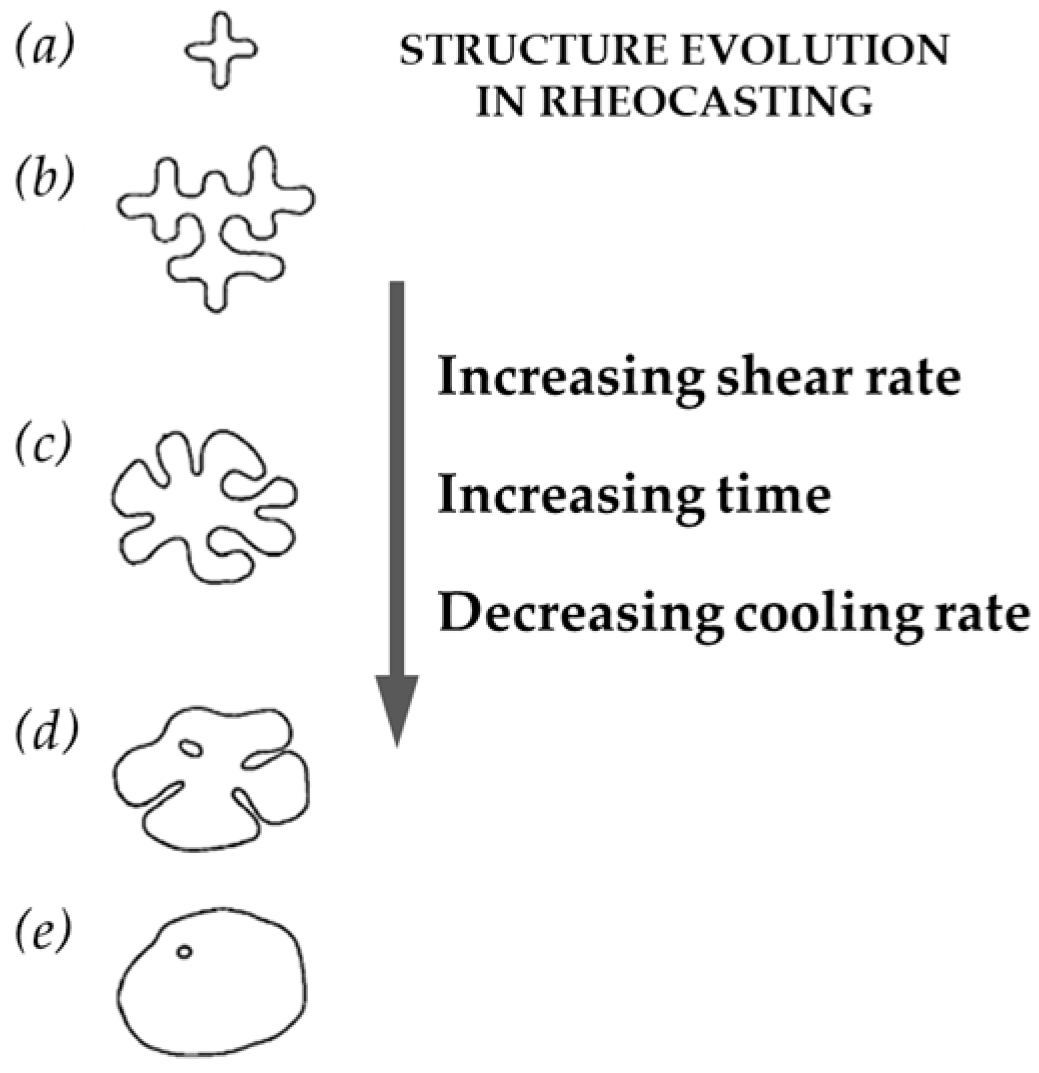

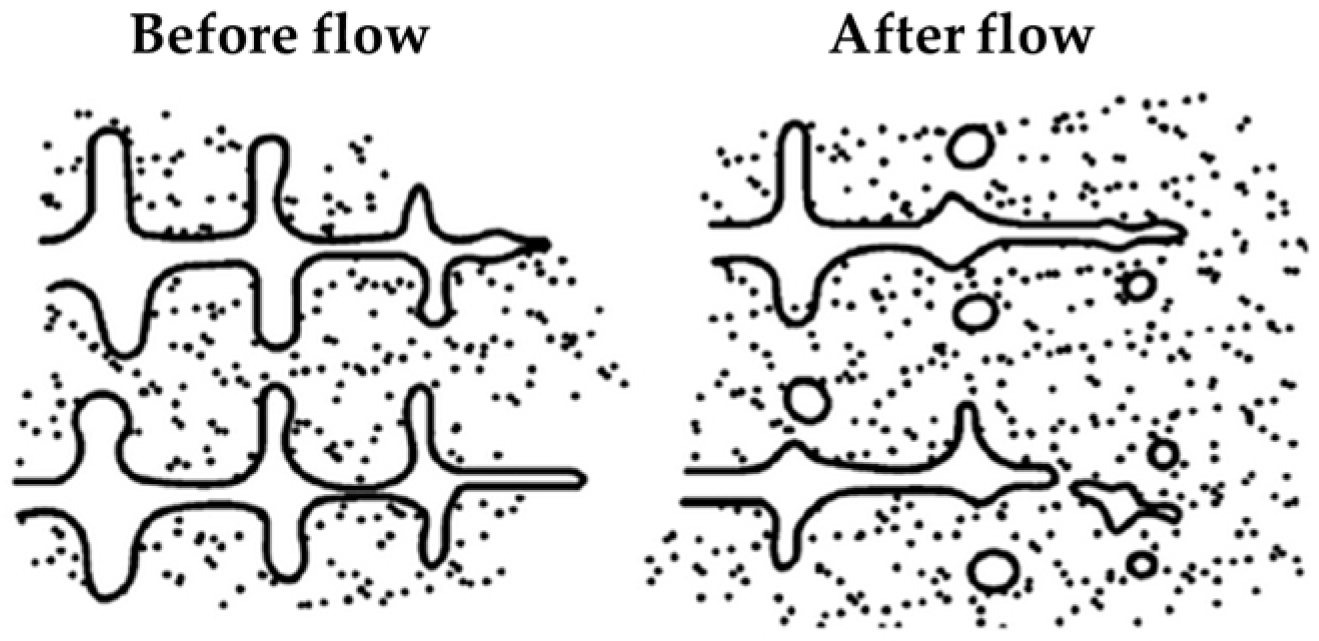
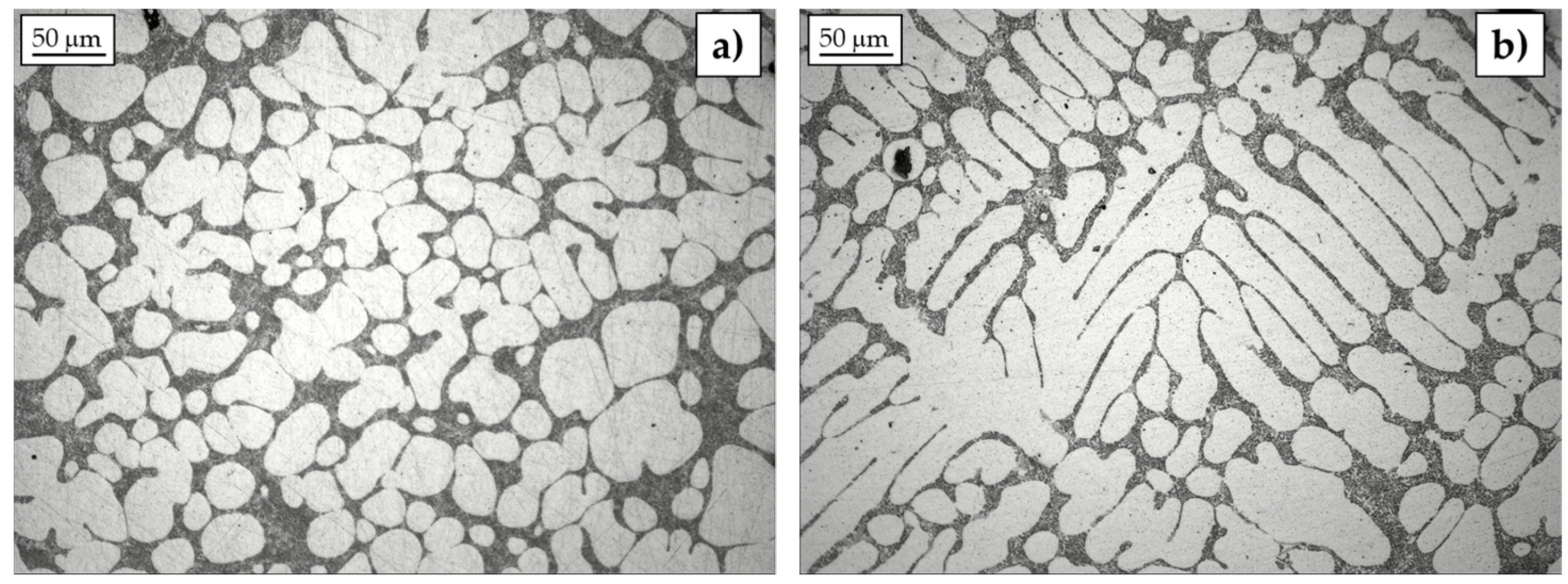


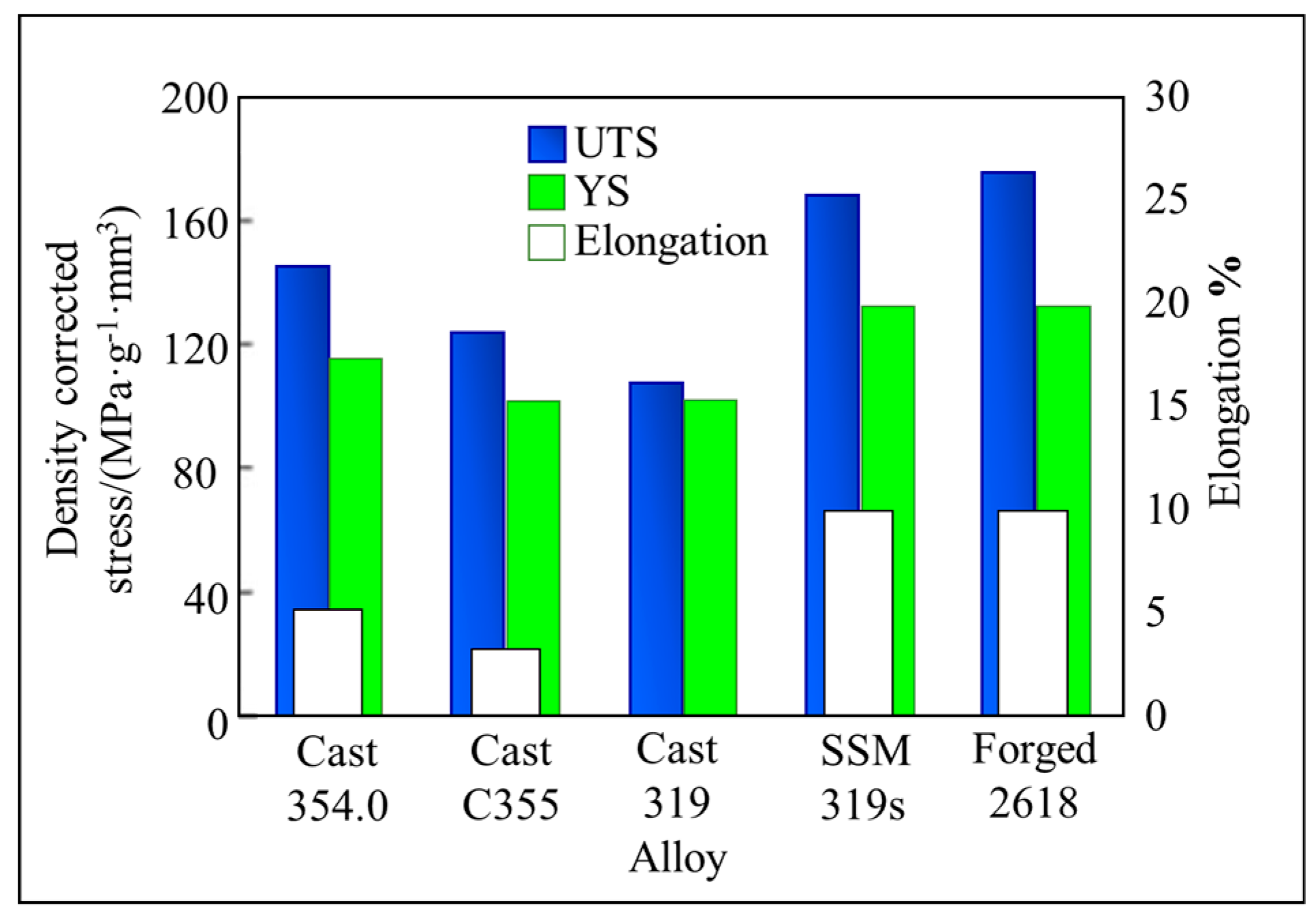
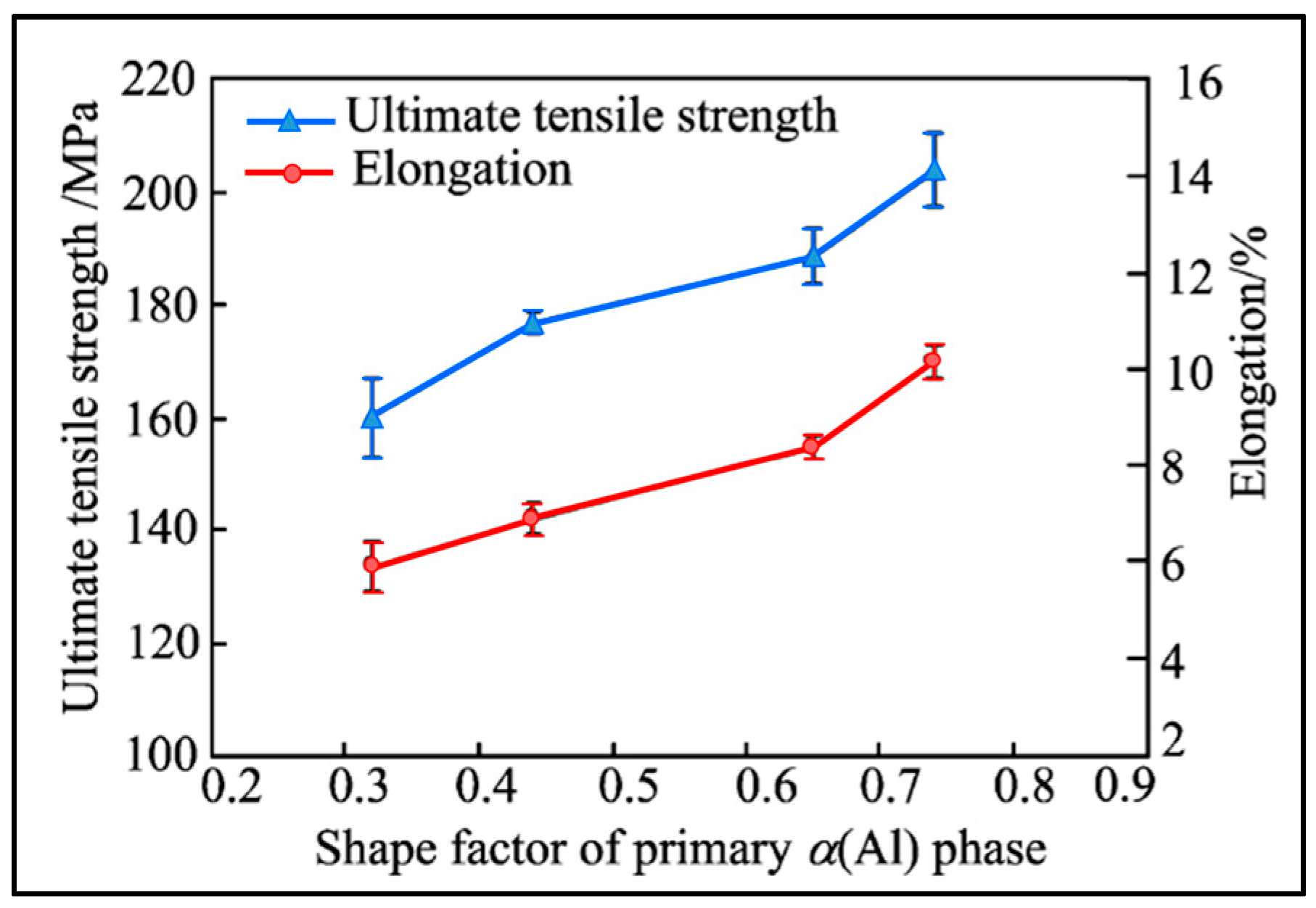

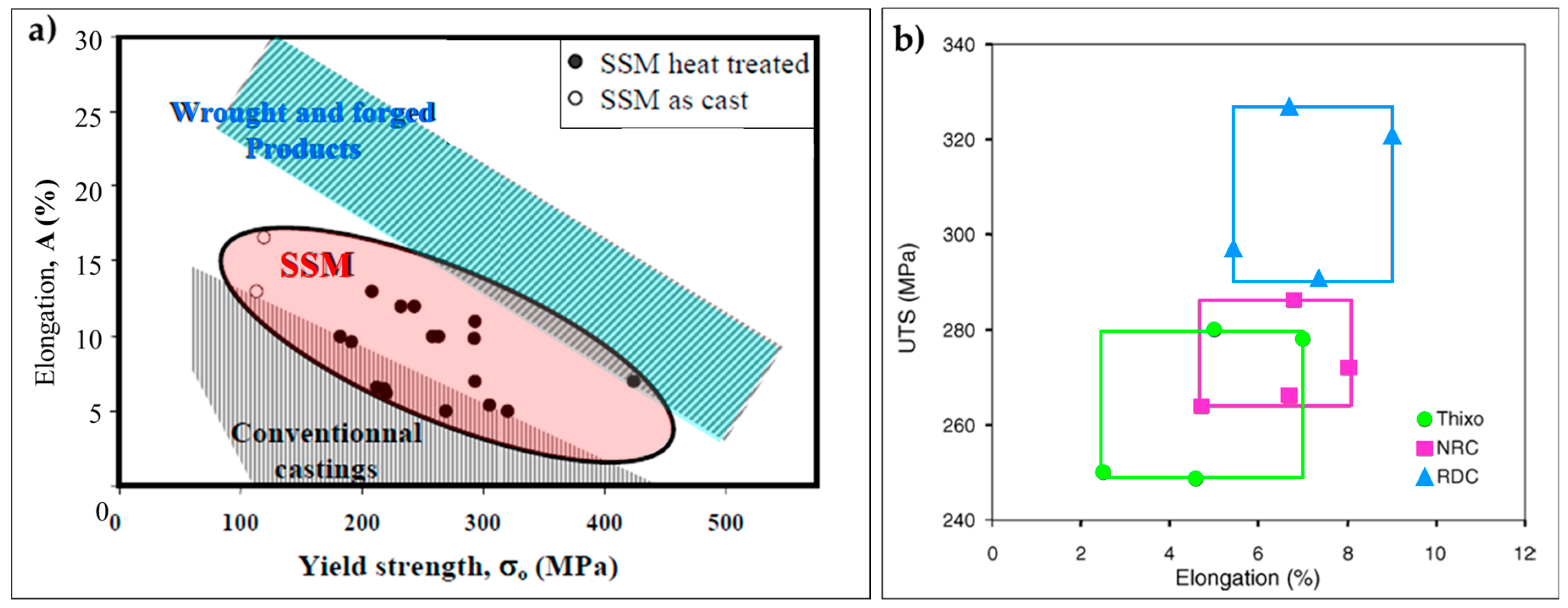
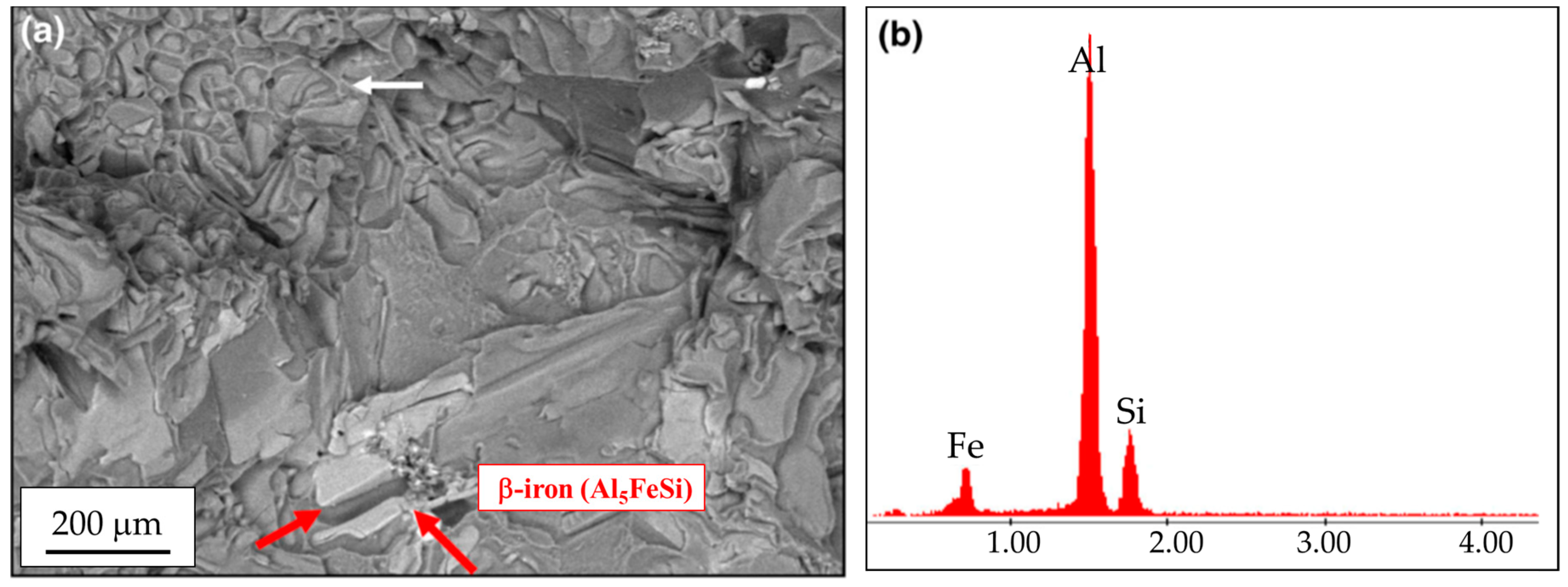

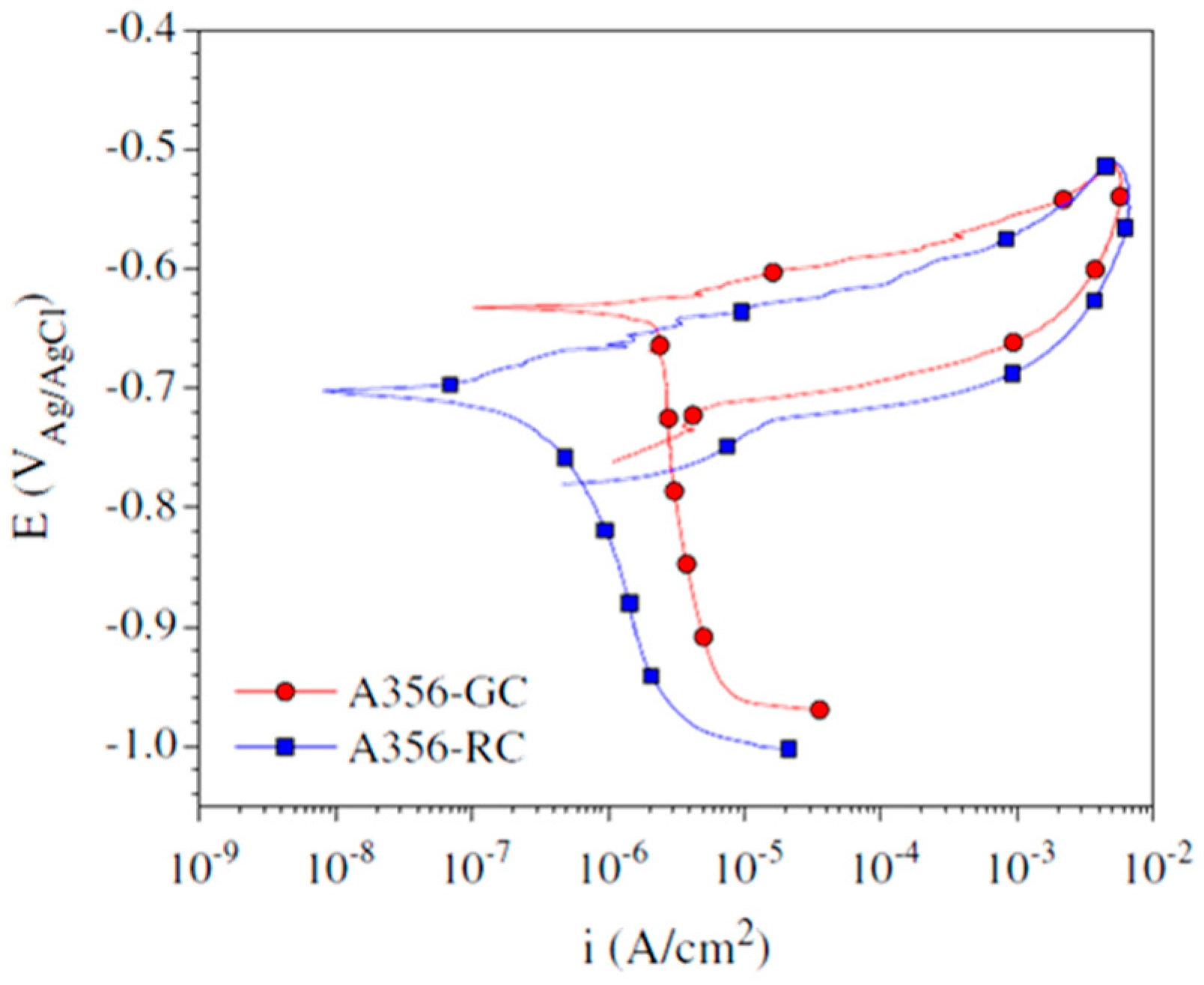
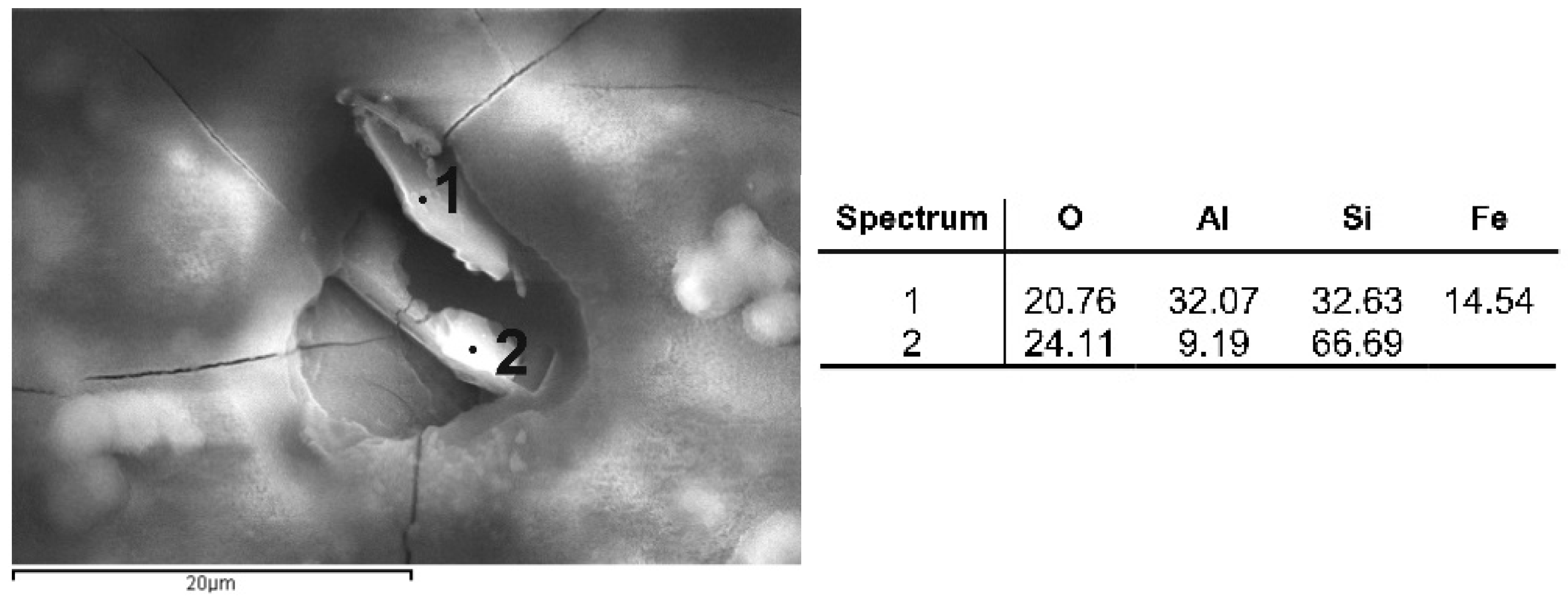
© 2018 by the authors. Licensee MDPI, Basel, Switzerland. This article is an open access article distributed under the terms and conditions of the Creative Commons Attribution (CC BY) license (http://creativecommons.org/licenses/by/4.0/).
Share and Cite
Pola, A.; Tocci, M.; Kapranos, P. Microstructure and Properties of Semi-Solid Aluminum Alloys: A Literature Review. Metals 2018, 8, 181. https://doi.org/10.3390/met8030181
Pola A, Tocci M, Kapranos P. Microstructure and Properties of Semi-Solid Aluminum Alloys: A Literature Review. Metals. 2018; 8(3):181. https://doi.org/10.3390/met8030181
Chicago/Turabian StylePola, Annalisa, Marialaura Tocci, and Plato Kapranos. 2018. "Microstructure and Properties of Semi-Solid Aluminum Alloys: A Literature Review" Metals 8, no. 3: 181. https://doi.org/10.3390/met8030181




